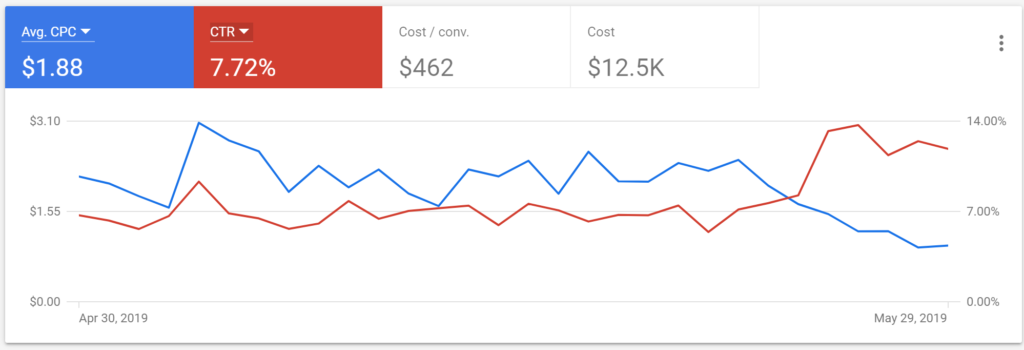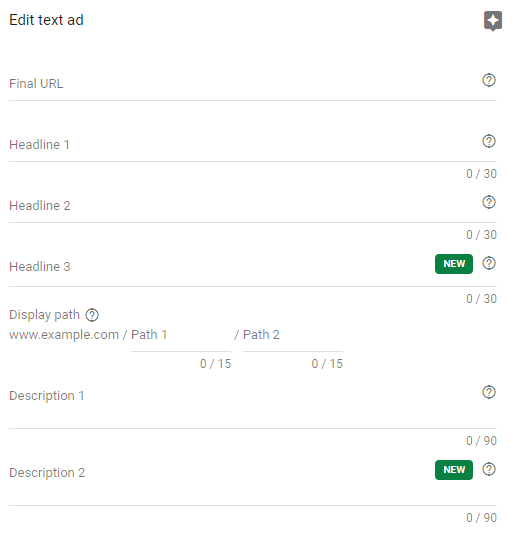7 Expert Google Ad Copy Guidelines
Google’s expanded text ads are like an online elevator pitch. You have a limited number of characters to capture the attention of people who are actively searching for your products or services.
If you want to stand out against the flurry of competition in the search listings, you need to ensure that your ads are relevant, attention-grabbing, and highlight your unique selling proposition immediately.
Look at how the click-through rate on our client’s ads increased dramatically after updating the ad copy. You can also see a sharp drop off in their cost per click as the relevance and quality of their ads increased.

There truly is an art to attracting clicks.
That’s why we’re sharing our 7 best practice tips for writing compelling Google ad copy.
1. Inject your target keywords into your ad
If you’re targeting a search like, ‘Brisbane hairdresser’, ensure that your ad copy includes the words ‘Brisbane hairdresser’. If your ad copy can address the exact query your potential new customer has entered into Google, you have a much better chance of capturing their eye in the search results.
Adding to that, make sure that your final URL and landing page also includes the words ‘Brisbane hairdresser’. This provides a consistent and seamless user experience.
Google will also determine that your ad will provide a better search experience, and in turn, your ad will be given a higher quality score. Therefore, you can pay less per click and you might end up seeing a nice performance graph like the one shown above.
Finally, don’t forget to add your target keywords to the display URL/ path!
2. Highlight your unique selling points (USPs) within your ad text
Why hide what makes you special? Communicate your USPs to quickly differentiate your business from the Google search competition. Make the most of your character limits and showcase the benefits of shopping or doing business with you.
The following phrases all have a place in your ad copy!
- Afterpay
- Free shipping
- Ongoing support
- Free set up
- Loyalty club
- Industry leader
3. Include a call to action within your ad
What should your target customer do next?
Compell them to click with a clear call to action.
This can be as simple as:
‘Shop The Collection Online Now.’
Or, as creative as ‘Complete Your Look With Shoes From …. ’
4. Highlight sales, promotions, and special deals
If you’ve got a sale or promotion – PUSH IT.
Naturally, a ‘20% off flash sale’ will do wonders for the click-through rate to your online store. You can also target searches for major online sales events, such as ‘Black Friday’ and ‘Frenzy Sale’.
Incorporate your latest sale promotion within your headlines and descriptions, as well as your promotion and site link campaign extensions. Adding extensions is a quick and easy way to customise and manage your ads.
5. Inject your brand personality
You’ve invested time, effort and money into creating your brand personality – USE IT!
Is your business the trusted industry expert? Or perhaps you’re the bubbly, playful brand? Review your style guide and filter your brand tone of voice into your ads.
Write something that will actively speak to your target audience within the search results. Always use an active, rather than a passive tone of voice.
For example, do you want to shop from a brand who ‘Strives To Offer The Latest Look’?
Or would you rather shop from a brand from which you can ‘Get The Latest Look’?
6. Split testing is a MUST
Include 3 expanded text ads within each ad group. This enables Google to test each ad within your group. It will also optimise to show the highest performing ad, by devise and user.
If your ad group is ‘Red Dress Online’ you should write three different versions of your ad to see which one performs the best.
7. Make the most of the Expanded Text Ad Structure
Expanded text ads are made up of headlines, descriptions, and paths.
Every headline (30 characters) and description (90 characters) is an opportunity to communicate a unique selling point. Therefore, you should ensure that the statements you make in each section add value.
In 2018, Google also announced a third headline and a second description which may or may not display depending on the search.
Therefore, it’s important to ensure your ad reads well with and without the third headline and second description. Read your ad as a whole and make sure your description lines flow – if you end your first description with the phrase, ‘Shop Now!’, you do not want to begin your second description with the same phrase.

Did you know that running responsive search ads alongside expanded text ads can also increase your click-through rate? Find out how to make the most of Google’s new responsive search ad format within your online advertising strategy.